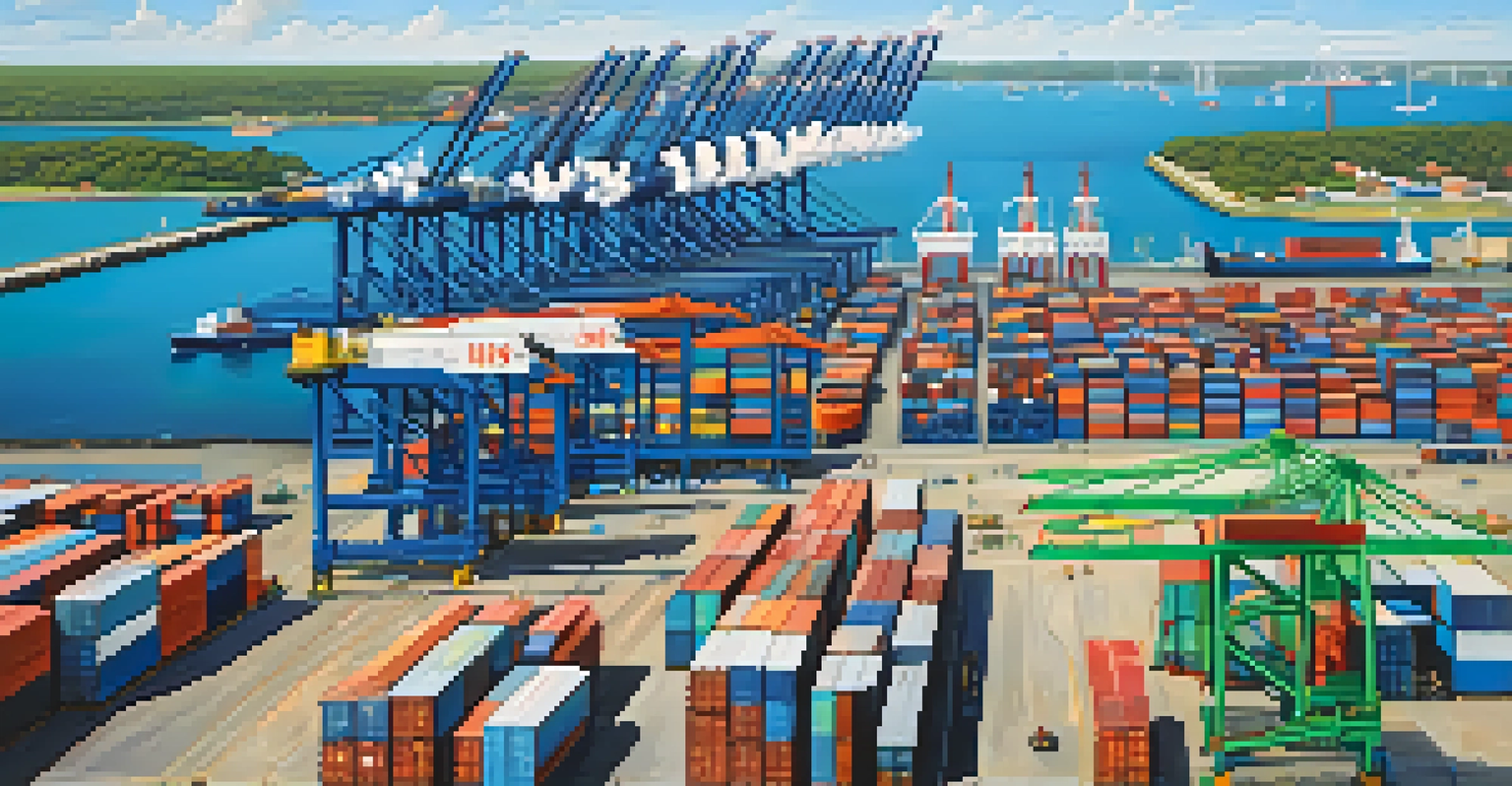Transportation Infrastructure and Economic Development in Georgia

Overview of Georgia's Transportation Infrastructure Landscape
Georgia boasts a diverse transportation infrastructure, featuring highways, railways, and airports that connect cities and regions. The state's extensive road network, including major interstates like I-85 and I-75, facilitates efficient travel and commerce. Additionally, Georgia's ports, particularly the Port of Savannah, rank among the busiest in the nation, enabling significant trade opportunities.
Transportation is the backbone of our economy, and our continued investment in infrastructure will ensure that Georgia remains a competitive hub for business and trade.
This robust infrastructure is not just about moving people; it’s essential for businesses looking to thrive. Companies can transport goods swiftly and reliably, which is crucial for maintaining competitive advantage in today's fast-paced market. Georgia's strategic location in the Southeast makes it a prime hub for logistics and distribution.
Moreover, the integration of various transportation modes helps create a seamless flow of goods and services. For instance, the ability to transfer cargo from ships to trucks or trains enhances operational efficiency. This interconnectedness is vital for economic development and attracts businesses to the region.
Economic Impact of Logistics and Transportation
The logistics and transportation sector is a cornerstone of Georgia’s economy, contributing billions in revenue and thousands of jobs. This sector includes everything from freight companies to warehousing and distribution centers, all of which rely heavily on the state's infrastructure. With Atlanta serving as a major transportation hub, the economic ripple effect can be felt across the region.

By facilitating trade, transportation infrastructure helps businesses lower their operational costs. Efficient transport routes mean faster delivery times, which can significantly enhance customer satisfaction. In turn, this leads to increased sales and profitability for companies operating in Georgia.
Georgia's Infrastructure Boosts Economy
The state's diverse transportation network, including highways, railways, and airports, plays a crucial role in enhancing trade and business efficiency.
Additionally, as more businesses recognize the advantages of Georgia's transportation system, investment in the state continues to grow. This influx of capital not only boosts local economies but also encourages the development of related industries, creating a thriving ecosystem that benefits everyone.
The Role of Airports in Economic Development
Air transportation plays a vital role in Georgia's economic landscape, with Hartsfield-Jackson Atlanta International Airport often cited as the world's busiest airport. It serves as a critical link for both domestic and international travelers, fostering business connections and tourism. The airport's extensive flight network allows Georgia-based companies to reach global markets with ease.
A robust transportation system is vital for economic prosperity, facilitating trade and improving access to markets for businesses across the state.
Moreover, the airport supports a wide range of jobs, from airline employees to hospitality workers. The economic impact extends beyond just those who work at the airport; it benefits local businesses that cater to travelers, such as hotels, restaurants, and transportation services. This ripple effect helps stimulate the economy in surrounding areas.
Investments in airport infrastructure, such as terminal expansions and improved runways, further enhance Georgia’s attractiveness to businesses. These improvements not only increase capacity but also enhance the overall travel experience, making it an appealing choice for companies considering relocation or expansion.
Highway System and Economic Connectivity
Georgia's highway system is a lifeline for economic connectivity, linking urban centers with rural areas. This network enables the movement of goods, services, and people, ensuring that businesses can operate efficiently regardless of their location. Highways like I-285 and I-20 are essential for facilitating commerce and providing access to markets.
The convenience of the highway system attracts various industries, including manufacturing and retail. Businesses benefit from easy access to both suppliers and consumers, which can lead to increased sales and a more robust local economy. Additionally, improved road infrastructure reduces travel time, allowing for quicker delivery of products.
Airports Drive Economic Growth
Hartsfield-Jackson Atlanta International Airport serves as a key connector for global markets, supporting local jobs and businesses.
As the population grows and urban areas expand, continued investment in highway infrastructure is crucial. Upgrades and expansions can alleviate congestion, ensuring that the state remains competitive and attractive to potential investors. This ongoing commitment to maintaining an efficient highway system is key to sustaining economic growth.
Rail Transportation's Contribution to Georgia's Economy
Rail transportation represents an important facet of Georgia's economic framework, providing an efficient means of moving bulk goods. The state's extensive rail network connects major cities and ports, facilitating the movement of products across state lines and into international markets. This efficiency is particularly crucial for industries such as agriculture and manufacturing.
Moreover, rail transport is often more cost-effective for long-distance shipping compared to road transport. For businesses that rely on heavy freight, such as coal or agricultural products, utilizing railways can significantly reduce costs and improve profit margins. This cost efficiency can make the difference in a competitive marketplace.
The continued development of rail infrastructure, including modernized tracks and expanded freight facilities, enhances Georgia's appeal as a logistics hub. As rail companies invest in technology and improvements, the potential for economic growth within the state increases, attracting even more businesses to the region.
Public Transportation's Role in Urban Development
Public transportation systems, such as buses and transit trains, are vital for urban development in Georgia’s cities. They provide residents with accessible options to commute, reducing reliance on personal vehicles and helping to ease traffic congestion. A well-functioning public transport system supports economic growth by enhancing mobility for the workforce.
Investing in public transportation infrastructure also encourages sustainable urban development. As more people utilize these services, it can lead to less pollution and a reduced carbon footprint. This aligns with broader goals of creating livable cities while supporting local economies through increased foot traffic in commercial areas.
Challenges Ahead for Transport Systems
Georgia faces aging infrastructure and funding shortages, necessitating strategic planning to adapt to future transportation needs.
Furthermore, reliable public transportation can attract new residents and businesses to urban areas. When people know they can easily commute to work or access amenities, it enhances the overall quality of life, making cities more desirable places to live and work. This, in turn, fosters economic growth and development.
Future Challenges and Opportunities Ahead
As Georgia's transportation infrastructure continues to evolve, several challenges and opportunities lie ahead. Aging infrastructure, funding shortages, and increasing demand for services require careful planning and investment. Addressing these issues is crucial to ensuring that the state can maintain its competitive edge and meet the needs of its growing population.
Moreover, advancements in technology, such as electric vehicles and smart transportation systems, present both challenges and opportunities. Adapting to these changes can enhance efficiency and sustainability, but it also necessitates a shift in infrastructure planning and investment strategies. Embracing these innovations will be key to future growth.

Ultimately, collaboration among government, businesses, and communities will be essential to navigate these challenges. By working together, stakeholders can develop solutions that not only improve transportation infrastructure but also bolster economic development. The path forward is filled with potential, and with the right strategies, Georgia can continue to thrive.